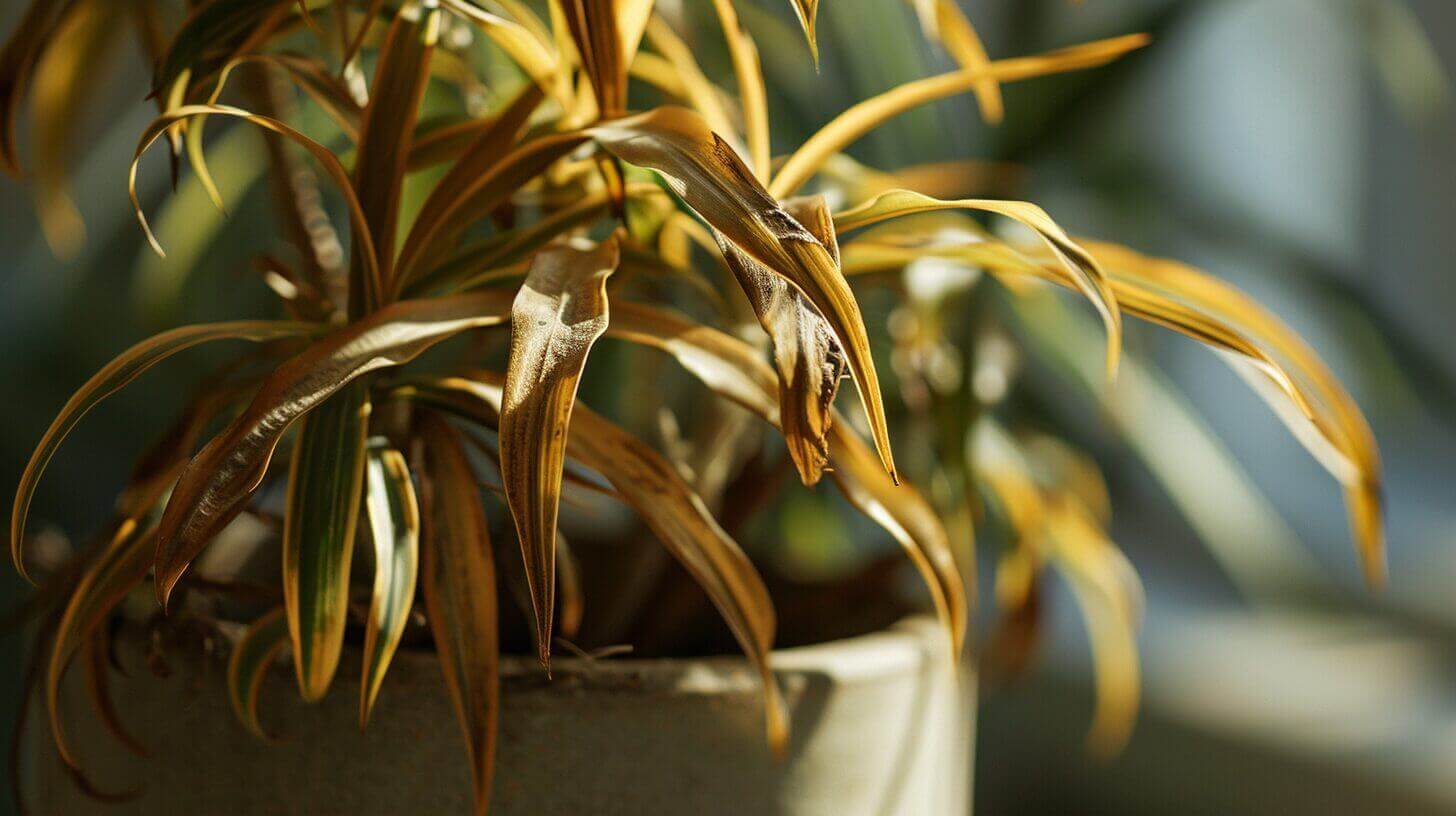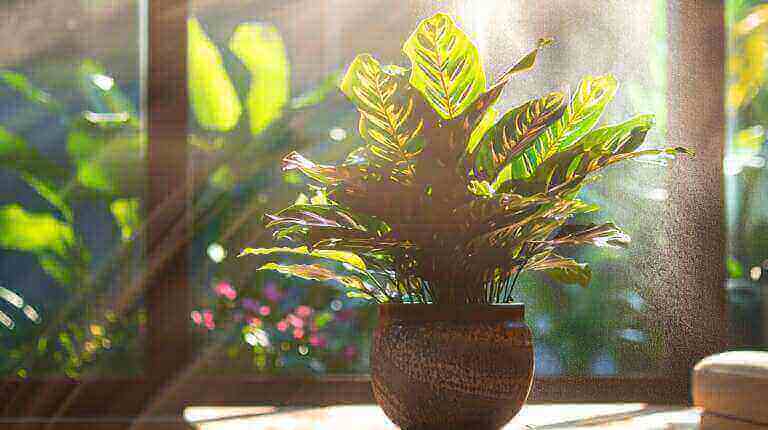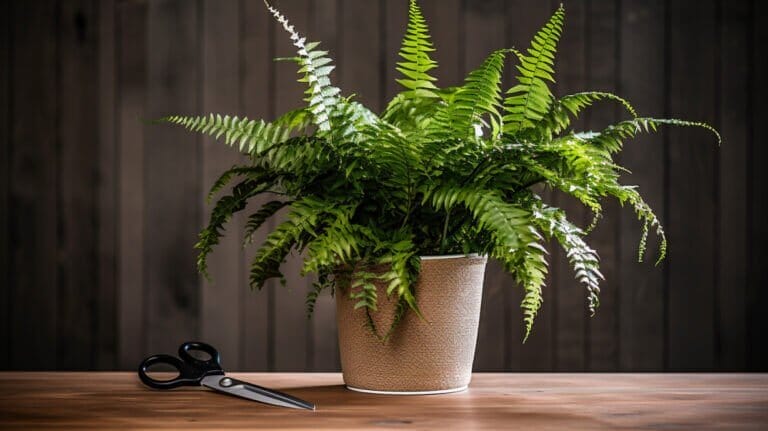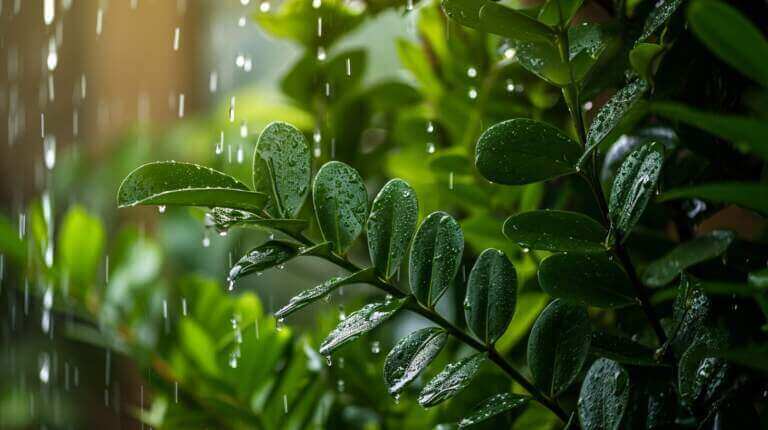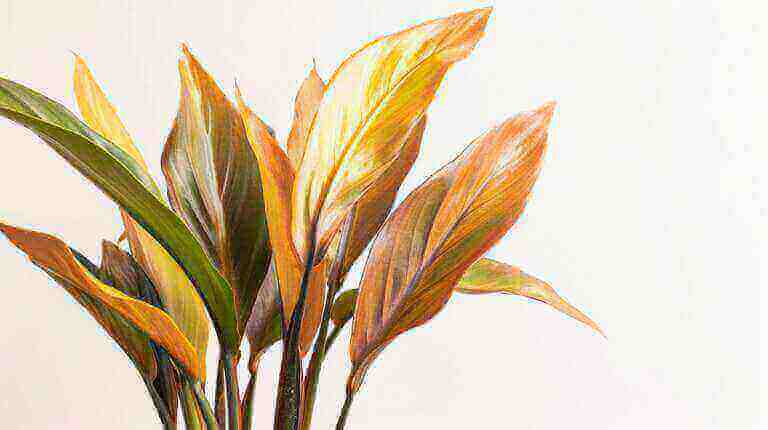Why is my Dracaena Leaves Turning Yellow? 5 Quick Fixes
Are you wondering why your Dracaena marginata plant’s leaves are turning yellow? Don’t worry, there are quick fixes to restore their vibrant green hue.
Key Takeaways:
- Lack of humidity and cold air exposure can cause yellowing and brown leaves, so ensure your Dracaena is in a suitable environment.
- Overwatering and underwatering are common causes of yellow leaves. Adjust your watering practices accordingly.
- Bacterial diseases, such as leaf spot, can occur due to overwatering, chilling, and insufficient light. Remove affected plant material and improve the plant’s environment.
- Various factors, including poor water quality, inappropriate potting mix, fertilizer burn, temperature changes, pest infestation, dry air, and chemical reactions, can contribute to yellow leaves. Take steps to address these issues.
- Preventing yellow leaves on Dracaena plants requires using filtered water, appropriate potting mix, maintaining stable temperatures, avoiding over-fertilization, treating pests, increasing humidity, and keeping chemicals away from the plant.
Factual data: If your dracaena leaves are turning yellow, there are several possible causes and solutions. First, lack of humidity can cause yellowing and leaf loss, so placing the plant on a dish filled with water and spray misting it can help. Cold air exposure can also cause yellowing, so make sure the plant is not near an open window or air conditioner. Overwatering can lead to yellowing and rotting, while underwatering can cause brown spots and wilted leaves. If these issues are present, adjust watering frequency accordingly. Bacterial diseases like leaf spot can occur with overwatering, chilling, and insufficient light; remove affected plant material and improve temperature, light, and ventilation. Older leaves naturally yellow and fall off. Additionally, poor water quality, cold or soggy potting mix, fertilizer burn, temperature changes, pest infestation, dry air, and chemical reactions can all contribute to yellowing leaves. Ensure the plant is watered with filtered or distilled water, use appropriate potting mix and adjust temperature, avoid over-fertilizing, prevent sudden temperature changes, treat pests, increase humidity, and keep chemicals away from the plant.
Common Causes of Yellow Leaves on Dracaena Plants
Several factors can contribute to yellow leaves on your Dracaena plants. Let’s explore the most common causes and how to address them.
Lack of humidity: Dracaena plants thrive in environments with higher humidity levels. If your plant is exposed to dry air, it can lead to yellowing and leaf loss. To combat this issue, place your Dracaena on a dish filled with water to increase humidity around the plant. Additionally, regular misting of the leaves can provide some relief.
Cold air exposure: Dracaena plants are sensitive to temperature changes and can experience yellowing if exposed to cold drafts. Keep your plant away from open windows or air conditioning units that can cause cold air to circulate around it. Maintaining a stable temperature within the recommended range for Dracaena plants can help prevent yellowing leaves.
| Causes of Yellow Leaves | Solutions |
|---|---|
| 1. Lack of humidity | – Use a dish filled with water to increase humidity around the plant. – Regularly mist the leaves to provide moisture. |
| 2. Cold air exposure | – Keep the plant away from open windows or air conditioning units. – Maintain a stable temperature within the recommended range. |
| 3. Overwatering | – Adjust watering frequency to prevent excessive moisture. – Ensure proper drainage to avoid waterlogged roots. |
| 4. Underwatering | – Water the plant thoroughly and consistently. – Check the soil moisture regularly to avoid allowing it to dry out completely. |
Overwatering: Too much water can lead to root rot and yellowing leaves. Ensure proper drainage by using a well-draining potting mix and pot with drainage holes. Adjust your watering frequency to prevent excessive moisture in the soil.
Underwatering: On the other hand, underwatering can also cause yellowing leaves. Make sure to water your Dracaena plant thoroughly and consistently. Check the moisture level of the soil regularly, ensuring it doesn’t dry out completely between waterings.
“Proper care and attention to humidity, temperature, watering practices, and environmental factors can help prevent yellow leaves on your Dracaena plants.”
These are just a few of the common causes of yellow leaves on Dracaena plants. Other factors such as bacterial diseases, natural leaf aging, poor water quality, fertilizer burn, and pest infestation can also contribute to yellowing. By adjusting the environmental conditions, using filtered water, choosing the right potting mix, avoiding over-fertilization, and treating pests promptly, you can help keep your Dracaena plants healthy and vibrant.
Correcting Humidity and Temperature Issues
Lack of humidity and exposure to cold air can lead to yellowing leaves in Dracaena plants. Here’s how you can correct these issues.
- Increase humidity: Dracaena plants thrive in humid environments, so it’s important to provide them with adequate moisture. One way to do this is by placing the plant on a dish filled with water and pebbles. As the water evaporates, it creates humidity around the plant.
- Mist the leaves: Regularly misting the leaves with water can also help increase humidity. Use a spray bottle to lightly mist the leaves, being careful not to drench the plant.
- Avoid cold drafts: Dracaena plants are sensitive to cold air, which can cause their leaves to turn yellow. Make sure to keep the plant away from windows, air conditioners, and drafty areas. If necessary, use curtains or screens to block cold drafts.
- Use a humidifier: If you live in a dry climate or struggle to maintain proper humidity levels, consider using a humidifier. This device releases moisture into the air and can help create a more favorable environment for your Dracaena plant.
By addressing humidity and temperature issues, you can prevent yellowing leaves and promote the overall health of your Dracaena plant. Remember to monitor the plant regularly and make adjustments as needed to ensure optimal growing conditions.
| Issue | Solution |
|---|---|
| Lack of humidity | Place the plant on a dish with water and pebbles, mist the leaves, or use a humidifier. |
| Cold air exposure | Avoid placing the plant near open windows or air conditioners, and use curtains or screens to block cold drafts. |
Adjusting Watering Practices for Healthy Dracaena
Proper watering is crucial for maintaining healthy Dracaena leaves. Let’s discuss how to adjust your watering practices to prevent yellowing. Overwatering is a common culprit behind why leaves of dracaena start turning their leaves yellow, as it leads to root rot and deprives the plant of essential oxygen. To avoid this, ensure that the top inch of soil is dry before watering again. You can check the moisture level by sticking your finger into the soil. If it feels damp, hold off on watering.
On the other hand, underwatering can also cause the leaves may turn brown or yellow. To address this issue, increase the frequency of watering. Dracaena plants prefer slightly moist soil, so aim to keep the soil consistently damp but not waterlogged. Be mindful of the pot’s drainage, as excess water can accumulate and lead to waterlogged conditions.
As each Dracaena plant varies in its water requirements, it’s crucial to observe the plant and adjust watering accordingly. Factors such as humidity, temperature, and the size of the pot can influence how quickly the soil dries out. Additionally, the time of year and the growth stage of the plant can also impact its water needs. So, it’s important to strike a balance by monitoring the plant’s response to watering and adjusting as needed.
| Signs of Overwatering: | Signs of Underwatering: |
|---|---|
| – Yellowing leaves | – Wrinkled or shriveled leaves |
| – Leaf drop | – Dry or crispy leaves |
| – Root rot | – Brown spots on leaves |
By adjusting your watering practices and being attentive to your Dracaena’s needs, you can prevent yellowing leaves and maintain a vibrant and healthy plant. Remember to provide adequate drainage, observe the moisture levels in the soil, and respond accordingly to changes in humidity and temperature. With proper care, your Dracaena will thrive and showcase its beautiful green foliage.
Dealing with Bacterial Diseases and Leaf Spot
Bacterial diseases and leaf spot can cause yellowing leaves in Dracaena plants. Let’s explore how to identify and address these issues.
When it comes to bacterial diseases, prevention is key. Overwatering, chilling, and insufficient light can create the perfect conditions for bacterial growth. To combat this, it’s important to remove any affected plant material promptly and improve the plant’s environment. Ensure that your Dracaena is not sitting in standing water and provide adequate drainage to prevent waterlogged roots. Additionally, adjust the temperature and lighting to maintain optimal conditions for your plant’s health. Proper ventilation is also crucial to prevent stagnant air, which can contribute to bacterial growth.
Leaf spot, another common issue in Dracaena plants, is characterized by dark spots on the leaves. To address this problem, you should remove any affected leaves or leaf sections. This will help prevent the spread of the disease. It’s important to be cautious when removing leaves and use clean tools to prevent further contamination. Clean your tools with a disinfectant between uses to avoid spreading bacteria. Once the affected leaves are removed, focus on creating a healthier environment for your plant by ensuring proper light, temperature, and humidity levels.
Summary of Solutions
- Remove affected plant material to prevent the spread of bacterial diseases.
- Avoid overwatering and provide proper drainage to prevent waterlogged roots.
- Adjust temperature, light, and ventilation to create optimal conditions for your Dracaena.
- Address leaf spot by removing affected leaves or leaf sections using clean tools.
- Maintain a healthy environment for your plant through proper light, temperature, and humidity levels.
| Bacterial Diseases | Leaf Spot |
|---|---|
| Caused by overwatering, chilling, and insufficient light. | Characterized by dark spots on the leaves. |
| Remove affected plant material promptly. | Remove affected leaves or leaf sections. |
| Avoid waterlogged roots by providing proper drainage. | Use clean tools to prevent further contamination. |
| Adjust temperature, lighting, and ventilation for a healthier environment. | Maintain proper light, temperature, and humidity levels for optimal growth. |
Other Factors Contributing to Yellow Leaves
Aside from the common causes we’ve discussed, there are other possible cause of yellow leaves on your Dracaena plants. Let’s explore these in more detail.
Water Quality
The quality of water you use to water your Dracaena plant can have a significant impact on its health. Tap water often contains chemicals such as chlorine and fluoride, which can be harmful to the plant. To ensure the best water quality, use filtered or distilled water when watering your Dracaena. This will help prevent the accumulation of chemicals in the soil and minimize the risk of yellowing leaves.
Potting Mix
The type of potting mix you use can also affect the health of your Dracaena. If the mix is too dense or retains too much moisture, it can lead to root rot and yellowing leaves. On the other hand, if the mix is too dry and lacks nutrients, the plant may suffer from nutrient deficiencies, resulting in yellow leaves. Make sure to use a well-draining potting mix specifically formulated for houseplants to provide the optimal conditions for your Dracaena’s root health.
Fertilizer Burn and Temperature Changes
Over-fertilizing your Dracaena can cause fertilizer burn, which can manifest as yellow or brown spots on the leaves. It’s important to follow the instructions on the fertilizer package and apply it sparingly. Additionally, exposing your Dracaena to dramatic temperature changes, such as moving it from a warm environment to a cold one, can stress the plant and lead to yellowing leaves. To prevent these issues, be mindful of proper fertilization practices and avoid subjecting your Dracaena to extreme temperature fluctuations.
Pest Infestation, Dry Air, and Chemical Reactions
Pest infestations, such as spider mites and mealybugs, can weaken your Dracaena and cause yellowing leaves. Regularly inspect your plant for signs of pests and take appropriate measures to treat and prevent infestations. Dry air can also contribute to leaf yellowing, as it deprives the plant of the necessary humidity. Consider using a humidifier or placing a tray of water near your Dracaena to increase moisture levels. Lastly, exposure to chemicals, such as cleaning products or aerosol sprays, can have adverse effects on your plant. Keep chemicals away from your Dracaena and ensure proper ventilation to minimize the risk of chemical reactions.
| Factors | Impact on Yellow Leaves |
|---|---|
| Water Quality | Chemicals in tap water can harm the plant and lead to yellow leaves. Use filtered or distilled water. |
| Potting Mix | Improper potting mix can cause root rot or nutrient deficiencies, resulting in yellow leaves. |
| Fertilizer Burn and Temperature Changes | Over-fertilizing and extreme temperature fluctuations can stress the plant and lead to yellowing leaves. |
| Pest Infestation, Dry Air, and Chemical Reactions | Pest infestations, dry air, and exposure to chemicals can weaken the plant and cause yellowing leaves. |
Tips for Preventing Brown & Yellow Leaves on a Dracaena
To keep your Dracaena leaves healthy and green, follow these tips to prevent yellowing and address potential issues.
- Use filtered or distilled water when watering your Dracaena. This helps prevent mineral buildup in the soil, which can lead to yellowing leaves. Avoid using tap water, as it may contain chemicals that can harm the plant.
- Choose an appropriate potting mix for your Dracaena. A well-draining mix that retains some moisture but does not become waterlogged is ideal. Avoid heavy soils that can cause root rot and ultimately lead to yellow leaves.
- Control the temperature around your Dracaena. Sudden temperature changes can stress the plant and cause leaf discoloration. Keep the plant away from drafty windows or doors, and ensure it is not exposed to extreme heat or cold.
- Prevent over-fertilizing your Dracaena. Too much fertilizer can cause salt buildup in the soil, leading to yellowing leaves. Follow the instructions on the fertilizer package and apply it sparingly, usually once a month during the growing season.
- Regularly inspect your Dracaena for signs of pest infestation. Common pests like spider mites and mealybugs can cause yellowing and damage to the leaves. If pests are present, treat them promptly with organic insecticidal soap or neem oil.
- Increase humidity around your Dracaena, especially if you live in a dry climate. Dry air can cause the leaves to dry out and turn yellow. Place a humidifier near the plant or use a pebble tray filled with water to increase moisture levels.
- Keep chemicals away from your Dracaena. Exposure to household cleaners, aerosols, or other chemicals can damage the leaves and cause them to yellow. Ensure the plant is placed in a location away from potential chemical exposure.
By following these tips, you can ensure that your Dracaena remains healthy, vibrant, and free from yellowing leaves. Remember to monitor your plant closely and make adjustments as needed to create the optimal growing conditions.
| Issue | Cause | Solution |
|---|---|---|
| Lack of humidity | Leads to yellowing and leaf loss | Use a pebble tray and mist the plant to increase humidity |
| Cold air exposure | Causes yellowing | Keep the plant away from drafts and cold windows |
| Overwatering | Results in yellowing and rotting | Adjust watering frequency to prevent waterlogged soil |
| Underwatering | Causes brown spots and wilted leaves | Water the plant regularly and ensure proper moisture levels |
| Bacterial diseases | Affected by overwatering, chilling, and insufficient light | Remove affected plant material and improve temperature, light, and ventilation |
| Older leaves naturally yellowing | Aging is a natural process for leaves | Regularly remove yellowing leaves to maintain plant health |
FAQ
Why are my Dracaena leaves turning yellow and brown?
Dracaena leaves can turn yellow due to various reasons such as lack of humidity, cold air exposure, overwatering, underwatering, bacterial diseases, natural leaf aging, poor water quality, cold or soggy potting mix, fertilizer burn, temperature changes, pest infestation, dry air, and chemical reactions.
How can I increase humidity for my Dracaena plant?
To increase humidity for your Dracaena plant, you can place it on a dish filled with water and regularly mist it with water. This will help prevent yellowing and leaf loss caused by lack of humidity.
What should I do if my Dracaena plant is exposed to cold air?
If your Dracaena plant is exposed to cold air, make sure to move it away from open windows or air conditioners. Cold air exposure can cause yellowing of the leaves.
How should I adjust my watering practices for my Dracaena plant?
If you notice yellowing and rotting due to overwatering, reduce the frequency of watering. On the other hand, if you see brown spots and wilted leaves due to underwatering, increase the frequency of watering.
How can I treat bacterial diseases and leaf spot in my Dracaena plant?
To treat bacterial diseases and leaf spot in your Dracaena plant, remove the affected plant material and improve temperature, light, and ventilation conditions. This will help prevent the spread of these diseases.
What can I do to prevent yellow leaves on my Dracaena plant?
To prevent yellow leaves on your Dracaena plant, make sure to water it with filtered or distilled water, use appropriate potting mix, avoid over-fertilizing, prevent sudden temperature changes, treat pests, increase humidity levels, and keep chemicals away from the plant.

